PRF New Directions Grantee Stories
In celebration of PRF’s 65 years of awarding grants, recipients of PRF Grants were invited to share their PRF stories. The stories of New Directions or equivalent grantees are below.
In the early 1980s the ACS Petroleum Research Fund was the only agency willing to support our high-risk research aimed at determining limits on the activation parameters for the automerization of 1,3-cyclobutadiene (doi: 10.1021/ja00387a065). The results of that research were surprising, as indicated in the final paragraph of our JACS communication: “Accordingly, we are forced to conclude that the entropy of activation for automerization of cyclobutadiene is probably negative and possibly substantially so. We are presently attempting to determine possible reasons for this phenomenon.” Subsequently, we concluded that the most probable explanation was that the reaction occurred primarily by heavy atom tunneling (doi: 10.1021/ja00344a073). Within the last few years, evidence has been accumulated to indicate that this seemingly surprising mechanism is actually at play in a significant number of reactions (doi: 10.1002/anie.201914943). On a more personal note, this research was arguably the principal accomplishment of my group during my time as an Assistant Professor at Cornell University. Consequently, it may well have contributed to my being granted tenure there. So, thank you PRF!
Dr. Barry K. Carpenter, Cardiff University, Cardiff, Wales, UK
The ACS PRF Doctoral New Investigator grant was the very first grant I wrote as a newly minted Assistant Professor. It was a highly accessible funding opportunity in that the proposals were shorter, and this means there was a low barrier to pulling together a good proposal quickly. Most importantly, the funding was sufficient to get a real project started. Later in my career, I applied for another ACS PRF grant as I started a new project in my group, a so called New Directions grant. I will always have great appreciation for the ACS PRF program and I think it holds a special place as an important funding source for both emerging and established researchers.
Dr. Christopher J. Ellison, University of Minnesota, Minneapolis, MN
With the New Direction seed proposal funded by ACS PRF, we are enabled to explore both fundamental science and unique properties of electroactive polymers and nanocomposites. These materials will find potential applications in sensors, artificial muscles, and energy harvesting devices. In particular, we have understood the working mechanism of electromechanical coupling in electroactive polymers such as poly(vinylidene fluoride) and nylons. The PRF support is critical for us to collect preliminary results for other funding opportunities, and it is also an excellent vehicle for education in science and engineering for the next generation workforce.
Dr. Lei Zhu, Case Western Reserve University, Cleveland, OH
In the mid-1980s my first job after grad school was with the University of Texas Institute for Geophysics where junior research scientists were required to raise 6 months of our 12-month salary through grants. I was eking out my salary with NSF funding. I also applied for a 2 year PRF grant as a way to support grad students to assist in the field studies I was doing as a follow-up to my own Ph.D. work in the Dominican Republic. The PRF grant supported two highly motivated and outstanding MS-level grad students: Christoph Heubeck who was put to work mapping in the desert-like southern DR (Christoph Heubeck) and Rudi de Zoeten who mapped in the lush, northern DR. Their successful field studies and RA support back at UT produced several published papers and maps that helped me along the research path. Thanks, PRF fund for that timely support!
Dr. Paul Mann, University of Houston, TX
As a young scientist I was immensely grateful for PRF funding during at least two occasions in the 1980s and 1990s when I had to support a family of five and did not yet have a position with financial security. I vividly remember the immense joy when I received the official confirmation of funding by snail mail, which lifted an enormous burden of anxiety from my shoulders. It was of paramount importance for my self-esteem and my resolve to continue my career in isotope geochemistry. Being close to retirement now, I can honestly state that PRF made a big impact in my life. I hope that PRF will be able to provide the same kind of crucial support for young scientists in the future.
Dr. Arndt Schimmelmann, Indiana University Bloomington
My group's research is primarily in materials science. The funding from ACS PRF allowed expansion of my group's research to include a new direction – heat transfer. This is allowing cross-talk between the fields and enabling interdisciplinary research, which my group members are thoroughly enjoying. Further, this led to a new collaboration with a reputed research group (Energy Transport Research Lab in the University of Illinois at Urbana-Champaign; PI: Prof. Nenad Miljkovic).
Dr. Arun Kota, North Carolina State University, Raleigh, NC
I am Ahmed Benkhayal, a graduate student at Ball State University working with Professor Nicholson. I have been involved with the geothermal project at the Department of Environmental Geology and Natural Resources (EGNR) since spring 2017. The project involves a vast database that includes well-logs, geological reports, seismic surveys, and geological maps, with a concentration on Southeast Asia. I used this data to evaluate the quality of the source rock Pematang Formation, Central Sumatra Basin, Indonesia, as part of my thesis for my MSc. Thankfully, the PRF grant (to Nicholson) covered my last year of the master's degree and the first two years of the PhD program so far. I am continuing to work on the geothermal project for my PhD. The geothermal team and I have published our work at several conferences during this time and we have a manuscript ready to submit. The PRF grand did not just help me in my education life; it has supported many undergrad students in the EGNR department who have helped with this project and gained valuable experience. Thus, we cannot thank PRF enough for helping us with our education life and a better chance for future success.
Dr. Kirsten Nicholson, Ball State University, Muncie, IN
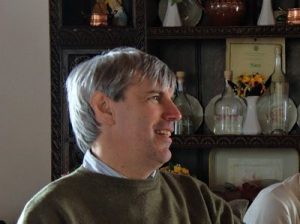
The PRF grant had a manifold impact on my career. It allowed us to successfully start a project on a class of enzymes with potential industrial applications. A decade later, those enzymes are indeed being applied in industry. Nice to see that we were on the right track! Likewise, the PRF project led to us to investigate those enzymes in humans. Very recently, we published the discovery of how these enzymes metabolize a plethora of compounds in humans. This a case where you start from petroleum chemistry to reveal aspects of human biochemistry. Being based in Italy, the grant awarded by PRF was particularly gratifying because it showed that our work was recognized in the American Society Community.
Dr. Andrea Mattevi, University of Pavia, Italy
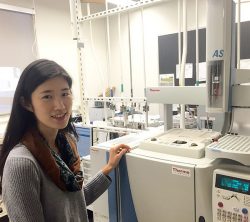
PRF-53747-ND2 launched my plant leaf wax research program in a new direction to study other plant biogeochemicals: lignin and lignite. As part of her PhD research, Dr. Hyejung Lee made progress on the quantitative determination of iodomethane using the “liquid method” dissolving iodomethane in isotoctane for GC-MS analyses and then she obtained concentrations across the lignin to lignite spectrum. Lee, H., Feng, X., Mastalerz, M., Feakins, S.J., Characterizing lignin: combining lignin phenol, methoxyl quantification and dual carbon and hydrogen isotopic techniques, Organic Geochemistry, 2019, https://doi.org/10.1016/j.orggeochem.2019.07.003
Fun fact: it’s an all-female author team!
Dr. Sarah J. Feakins, University of Southern California, Los Angeles, CA
PRF starter grant was my first grant when I became a junior faculty at an undergraduate institute. Prior to my receiving of the grant, the program officer actually came to view my poster at an ACS meeting and inquired about my research project. This first grant enabled me to work with a number of undergraduate researchers and generated interesting preliminary results, which were published as several journal papers. A few years later, a regular UG PRF grant allowed me to implement another fascinating project on desulfurization, resulting in publications with students in top-chemistry journals. After moving to a doctoral-granting institution, PRF supported me again on a New Direction project that widened the horizon of my research. Overall, PRF not only supported me as a junior faculty and provided me with seed money, but also allowed me to explore new territory of research. Another major impact of PRF is its passionate support of both undergraduate and graduate students on research, presentations and publications.
Dr. Hua Zhao, University of Northern Colorado, Greeley, CO
PRF seed money for fundamental research on the phase behavior of polycyclic aromatic hydrocarbon (PAH) oligomers has led to significant funding from DoD over the past few years!
Dr. Mark C. Thies, Clemson University, Clemson, SC
PRF type G was the very first grant I obtained as a new assistant professor. It help me learn how to focus my thoughts and write a strong proposal, laying the foundation for my future successes in funding. PRF funds were invested in my first graduate students who have all had extremely productive and successful careers in chemistry. The novel layered materials that I wrote about and was originally funded for have been shown to be important for catalytic applications although that wasn't the focus of my proposal. Not only did the funding impact my research group, but provided initial manuscripts in the field that lead to even more new chemistry.
Dr. Susan Kauzlarich, University of California, Davis
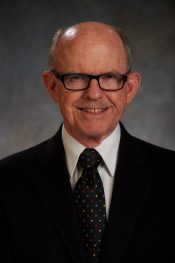
I was a young Assistant Professor at Louisiana State University, in Baton Rouge, when I received the PRF Type G grant, my first grant as in about 1970. Costs were low then, and the funding was important and launched my academic career. My first computations were facilitated by these funds and the seed for what eventually became my principal research interest - understanding the electronic origins of reactivity and selectivity in organic and biological reactions. My next major interaction with the PRF was as a member of the PRF Advisory Board in the 1990s. Fifty years after my PRF Type G grant, I still pursue those ideas born in the 1970s, now as the Saul Winstein Research Chair in Organic Chemistry at UCLA.
Dr. Kendall N. Houk, University of California, Los Angeles
PRF grants have provided me opportunities to educate students, publish papers and theses, and seed new research related to two different areas of petroleum research, namely drag reducing polymers and waxy oils. Our current project investigates wax appearance temperature under different shear, temperature, and pressure. The PRF grant offers an opportunity to provide a more complete phase diagram and understanding of flow-induced phenomena in waxy oil systems, which is an important flow assurance problem. Students are using state of the art equipment to gain hands-on laboratory experience, specifically rheometry and scattering. Two graduate students, an undergraduate student, and a visiting researcher have been working collaboratively to advance this project and grow professionally.
Dr. Matthew Liberatore, University of Toledo, OH
My first competitively won research grant as a beginning assistant professor was from ACS-PRF, at a time when my independent career was first starting. It gave me some much-needed validation for research ideas and support to get my program going. I will always be grateful for the faith shown in me by the program officers and reviewers at ACS-PRF.
Dr. Steve Creager, Clemson University, Clemson, SC
The PRF grant that I received as an Assistant Professor at North Dakota State University was a tremendous boost to my career as a researcher. Using the PRF funds, I was able to support a graduate student at NDSU and get my research program on the simulation of coatings off the ground. I am now a Distinguished Research and Development Staff Scientist at Oak Ridge National Lab. I doubt very much if I would have been able to make that leap were it not for the help afforded by the PRF grant. I will always be grateful for the opportunities that were opened by the grant that I received early in my career.
Dr. Randy Fishman, Oak Ridge National Laboratory, Oak Ridge, TN
I remain deeply grateful to the PRF for a small grant at a crucial time during a hiatus in my regular funding.
Dr. John F. Nagle, Carnegie Mellon University, Pittsburgh, PA
As a beginning professor about 25 years ago, a PRF grant was the first competitive grant that I was able to secure. The funds were invaluable at the time, and got my research program up and going. I am forever grateful to the PRF for this help in my career
Dr. Jeremy B. Fein, University of Notre Dame, South Bend, IN
Metal anions. The chemical concept of metals producing positive ions is a fundamental precept taught as early as high school. However, under certain conditions metal anions can be created and as such their electron affinities (EA) are well characterized both experimentally and theoretically. In the gas phase, negative metals ions are prepared in very specialized apparatus, either through double electron capture in beams, in discharges and in sputter ion sources. Since our original paper in 2010 outlined a method for producing metal anions from a simple oxalate salt solution and a commercial mass spectrometer, we used our PRF Grant to explore the use of atomic metal anions as reagents in gas phase ion-molecule reactions. As one reviewer stated “Excellent idea and work". This was undertaken by undergraduate (J. DiMuzio, A. Mungham, J. Roy, D. Hassan, S. Wood ) and graduate (J. Butson, J. Halvachizadeh) and postdoctoral (B. Francisco) researchers and resulted in publications outlining the reactions of atomic metal anions with small nucleophiles, alcohols and hydrocarbons, halogenated aromatics and small polyatomic oxides. We have literally written the book on the ion-molecule chemistry of this family of exotic species.
Dr. Paul M. Mayer, University of Ottawa, Ontario, Canada
PRF funded a project of mine around 1990 with the approximate title of "Traveltime Tomography without Rays". It showed how do invert for the subsurface velocity model using the wave equation rather than the high-frequency approximation of ray-based tomography. The associated paper in Geophysics "Wave Equation Traveltime Tomography" by Luo+Schuster garnered more than 700 citations by 2020. It is the 2nd-most citations of any paper I have written and has lead to its use in many different inversion methodologies.
Dr. Gerard T. Schuster, King Abdullah University of Science and Technology, Thuwal, Saudi Arabia
A PRF grant helped get my academic career started. The research it supported was the basis of one of my first independent publications.
Betz, S. F., and Pielak, G. J. (1992) Introduction of a disulfide bind into cytochrome c stabilizes a compact denatured state. Biochemistry 31, 12337-12344. That paper has been cited 86 times. I earned tenure and moved up the ranks, and my then grad student co-author is now Vice President of Crinetics Pharmaceuticals. Thank you PRF.
Dr. Gary J. Pielak, University of North Carolina-Chapel Hill
My first grant ever was from PRF in 1977. This was in the days when there was very little startup funding from my university, so getting this grant in my second year on the faculty was crucial to getting my research program going, and I used the $9,000 grant partially to support a graduate student, and partially to buy my first computer, an 8-bit minicomputer from Data General. This support helped me to get going on computational research concerned with gas phase chemical reactions that are important in combustion and atmospheric chemistry, and ultimately I worked in that field, supported by other agencies, for nearly 20 years after 1977. Of course science changes, and I was fortunate to get PRF support for other new directions of my research in 1991 and 1995. Some of this later support has concerned research that I'm still involved in now.
Dr. George C. Schatz, Northwestern University, Evanston, IL
My PRF starter grant was the first proposal-based external funding I landed as an Assistant Professor at Georgia Tech in the 1990s. Almost a quarter of a century later, I remain thankful for this initial vote of confidence from PRF and often recommend that new faculty members seek out PRF support to launch their research programs while they await success on their first round of national funding agency proposals. The PRF grant came at a critical time in my career and launched a productive line of research. The initial product, as well as the products that emerged from subsequent, related research, have stood the test of time. Most importantly, the research allowed me to forge a collaboration with a then-postdoc at the U.S. Geological Survey. That scientist has become one of my closest long-term colleagues and collaborators in my current position with the USGS Gas Hydrates Project. I am truly appreciative of the vote of confidence PRF's funding provided at an important time in my early career.
Dr. Carolyn D. Ruppel, U.S. Geological Survey, Woods Hole, MA

The PRF grant was instrumental in helping me launch a new area of my research, and in general, helping me establish my lab as an assistant professor at the University of Montreal. Specifically, the PRF-enabled research investigates electrochemical reactions at hybrid interfaces with the aim of using secondary coordination sphere effects to rationally dictate reaction pathways. This research is still in its infancy in my lab so stay tuned to see what comes out over the next couple of years.
Dr. Nikolay Kornienko, University of Montreal, Quebec, Canada
RE: PRF # 46310-AC5, “Electrokinetic Behavior and Passage of Polyelectrolytes and Surfactants throughout Tortuous Micro/Nanopore Media”
Just a note to express the researchers’ great appreciation for this grant assistance. Information and experience gained in the course of the funded work has enabled our group to establish new understandings related to (a) interpretation of electrokinetic data in the case of mesoporous materials, (b) the behavior of polyelectrolytes relative to their interactions with porous materials, and (c) kinetic aspects related to the diffusion of polymer solutes into porous materials. The results have led eventually to the publication of about 15 articles, which have been widely cited.
Dr. Martin A. Hubbe, North Carolina State University, Raleigh, NC
I received my first PRF type G grant, as it was called then in May 1980, in the first year of my academic career. It was also my first research grant ever, and I remember running to the Department Heads office to give him my “great news”. To his credit he did show (feign?) excitement. It was a pivotal event in my academic experience, and gave me the confidence to apply for larger grants. The following year I was successful in using the data I had generated from my PRF grant in getting an NSF grant on essentially the same topic. While NSF in general does not like to co-fund a project, the NSF project manager understood that PRF grants were meant for this purpose. Later in my career I thought about using molecular dynamics to study the entire reverse osmosis process with no evidence to show it could be successful. To my surprise, my proposal to PRF, this time for a type AC grant got funded, after several were not that were not completely different from my previous research. The new PRF grant also led to several years of funding from the Department of Energy. PRF has always been at the forefront of funding new ideas. It has had an enormous impact on my academic career, for which I will be eternally grateful.
Dr. Sohail Murad, Illinois Institute of Technology, Chicago, IL
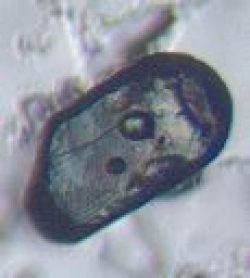
The PRF grant that I received when I was an Assistant Professor was critical to the success of my lab group and to development of a new geochronologic technique that is now widely used. "Double-dating" (determination of both U/Pb and (U-Th)/He ages) of detrital zircon grains in sediments and sedimentary rocks is now widely used to trace the provenance and histories of sediments in a diverse range of fascinating geologic studies, and was pioneered by students and researchers using resources from our PRF grant. We are extremely grateful to the PRF for making possible innovative basic science that continues to positively impact experiences and careers of students and faculty, and transform geosciences. Photo: A single (~100 micrometer) detrital zircon grain from the Navajo Sandstone, with a laser-ablation pit visible on one side, that made the trip from the Appalachian Mountains to the Colorado Plateau almost 200 million years ago.
Dr. Peter W. Reiners, University of Arizona, Tucson, AZ
The ACS-PRF New Directions awarded to my research group played a pivotal role toward branching into an entirely different research area and contribute impactful science to new chemical directions. The grant we received was directed towards new fluorescent dyes with very unique features known as panchromatic emission. The observation of white light from multiple lamba maxima from a single, small-molecule organic dye became the bridge between our expertise in dual fluorescent probes for biomolecule detection in solution to solid-state electrochromic materials. Ultimately, this new direction materialized into more of a quantum leap as my students became familiar with ultra high vacuum, low temperature deposition techniques for fabrication of OLEDs; specifically in our case, white organic light emitting devices. Those pioneering results led to a pair of impactful publications (20 citations since 2014):
(1) Current Organic Chemistry 18 (6), 740-772, 2014.
(2) The Journal of Physical Chemistry A 121 (51), 9708-9719, 2017.
Several students were supported by this award and have graduated to professional careers in science. Furthermore, my research expanded from a rather straightforward translation between electroluminescent (LED technology) to electrochemical and photocatalysis. An area where my group received considerable support from NSF.
Dr. Michael D. Heagy, New Mexico Institute of Mining and Technology, Socorro, NM
PRF grants have a significant impact on my research career and in turn helped my students greatly. This is especially true in the beginning years of my career. My teaching load was reduced because of receiving a starter PRF grant. Trying to apply for funding has been a frustrating and exhausting experience. I have received complementary reviewers' comments in my grant applications to other funding agencies. However, grants seem always late to arrive and my research project risked running out of funds. My graduate students and undergrads were almost out of support. In several times of my career at Miami University, PRF grants came as fresh water in a summer desert. I am very motivated in carrying out my research projects, and the relief that a PRF grant provided me with more time and energy to excel and focus on my students and research. I am excited that I can work in the field of petroleum research, but will also have opportunities for applying related grants in the field. PRF grants have helped me compete and winning research funding from other agencies and allowed me the best opportunity to fully develop my ideas to the best of my ability.
Dr. Benjamin W. Gung, Miami University, Oxford, OH
I have received a PRF DNI grant in 2014, my second year as an assistant professor at the University of Minnesota. PRF was my first external grant, which allowed me to initiate my research program quickly and gain useful experience on proposal writings. The results from the PRF-supported project were of importance for me to apply grants from NSF and DOD later. Thus, I am very grateful for the support of PRF. I have also been awarded a PRF ND grant last year. I am looking forward to start the grant in the coming September, which will provide us necessary seed money to start a new research direction in my research group. Based on my experience, I strongly believe that PRF provides a unique and invaluable funding opportunity, particularly for junior scientists who have just started their career and researchers who have switched their research directions. I wish PRF to continue its success in the next 65 years and make an even larger impact in the academic community.
Dr. Xiang Cheng, University of Minnesota, Minneapolis, MN
Although a change of interests has long made my work ineligible for PRF grants, my respect and gratitude remain. The PRF was always willing to support a graduate student to begin the no-guarantee type of research that scientists love most, and the outcomes always led to interesting research papers. I wish PRF the best, and hope that it will always retain its youthful spirit.
Dr. Neil Frazer, University of Hawaii at Manoa
My PRF grant is giving me and my students the opportunity not only to undertake research in a new area of chemistry, but also the chance to work with a team in another country. The grant was funded with me as the Principal Investigator and a collaborator in Birmingham, England as a Co-Investigator. The two groups have been able to work symbiotically on the project. We also have each sent a student to the other group's laboratory. For me, this involved one of my graduate students spending two months in the United Kingdom as part of her Ph.D. This experience transformed her research and also her perspectives on life. She learned such a great deal while in the UK and relished the opportunity to explore another country and culture. Likewise, the student from the UK had a fantastic experience in Connecticut - seeing how a different laboratory does chemistry and also a part of the world he had never been previously. We are truly appreciative of the support from the PRF which is the catalyst for us to push forward with new organic chemistry, dream up fresh ideas, and spark new friendships.
Dr. Nicholas Leadbeater, University of Connecticut, Storrs, CT
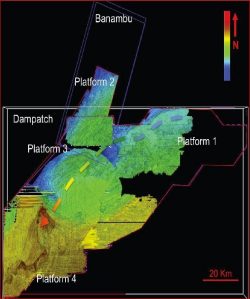
In 2000, I received an ACS-PRF grant entitled “Continuing the Global Search for a Eustatic Signal: Three-Dimensional Relationships between Late Paleogene-Early Neogene Seismic Stratal Surfaces and Paleobathymetry, Northern Carnarvon Basin, Northwest Shelf, Australia”. Using two-dimensional and three-dimensional seismic reflection control and commercial well results, that grant allowed my research team, which over the next decade included two matriculated Ph.D. students, a MS student, and a visiting scientist from China, to 1) analyze, interpret and map seismic sequences and facies, enroute to 2) understanding the dynamic evolution of a complex deltaic accumulation, 3) serving in turn as the foundation for a series of migrating carbonate platforms, all evolving over millions of years in response to both eustatic sea-level and climatic fluctuations. All of these sediment accumulations, occurring on the northwest shelf of Australia, also responded to physical oceanographic changes as the continent migrated northward towards southeast Asia. Using these results, peer-reviewed papers were published in AAPG Bulletin, Basin Research, Marine Geology and Continental Shelf Research. This long-term research also became a primary driver of a successful scientific ocean drilling effort, IODP Expedition 356 (“Indonesian Throughflow”), conducted in 2015.
Figure: Schematic representation of four mapped, Pliocene-Pleistocene carbonate platform tops on the Northwest Shelf of Australia (from Goktas et al., Continental Shelf Research, 2016).
Dr. Jamie Austin, University of Texas at Austin
I was fortunate enough to receive PRF support as a starting faculty member, exploring connections between rock decay (weathering) and the global carbon cycle. This support enabled field work and electron microscope studies to measure for the first time, long-term (thousands of years) rates of carbon sequestration by dissolution of Ca-Mg bearing silicate minerals -- published in journals like Geochimica Cosmochimica et Acta with wonderful collaborators. This initial PRF support enabled the placement of samples for a 25-year geobiological study of the role of different agencies on rates of carbon sequestration by silicate mineral dissolution. I am grateful that the PRF supports starting researchers, helping them establish pathways of exploration in the petroleum field.
Dr. Ronald Dorn, Arizona State University, Tempe, AZ
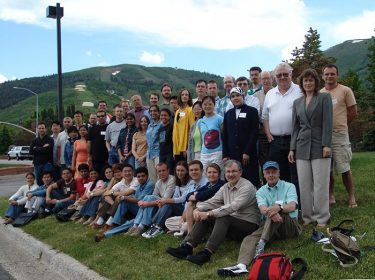
In 2005, I used funding from ACS-PRF to host a week long summer school on theoretical chemistry in Park City, Utah. At this web site one can access all of the lecture materials from the school lecturers http://simons.hec.utah.edu/school/index.html. Below, I show a group photo in which most of the students and lecturers (myself, Rick Heller, Emily Carter, Jim Doll, John Tully, Ken Jordan, Tamar Seideman, Joan-Emma Shea, Martin Head-Gordon, and Tom Cheatham) are shown. Based on the success of this summer school, I was able to raise funds (through personal donations, from ACS-PHYS, the Dreyfus Foundation, and the American Conference on Theoretical Chemistry) to create an endowment upon which the new Telluride Schools on Theoretical Chemistry (https://www.telluridescience.org/schools/tellurideschoolontheoreticalchemistry) has been established. These schools, held every two years since 2009 (below I show the group photo from that school) and continuing through 2019 and beyond, allow ca. 30 advanced Ph D and postdoctoral students to improve their background in the field. This legacy is something that I hope ACS-PRF can be proud of.
Dr. Jack P. Simons, University of Utah, Salt Lake City, UT
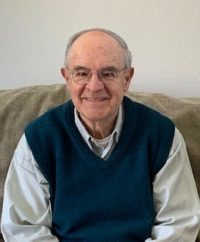
I received a PRF G grant in 1969 as a first year assistant professor of chemistry at the University of Colorado Boulder. By today’s standards, the grant was small but it was equal in dollars to my total startup package from the University. The funding was used to purchase small equipment items and supplies for the research of my first graduate students. Their research success led to a communication in JACS, a paper in Tet Let, and preliminary results for new projects that ultimately led to a PRF AC grant and an NIH grant. Subsequent funding came from numerous agencies, federal and private, 37 PhD students, and more than 150 publications and patents. Physical organic chemistry was a central theme, but the research ranged from biochemistry through physical chemistry over a period of 50 years. I give my thanks to PRF for help in starting my academic career and to the ACS to which I have been a member for more than 55 years.
Dr. Tad H. Koch, University of Colorado Boulder
My PRF grant was my first funding support since starting my academic career, and I am very grateful for PRF support that jump-started my research in n-type polymers with applications in energy storage devices. My students were able to attend an ACS meeting and broaden their horizon through the PRF travel support.
Dr. Tse Nga Ng, University of California, San Diego
The New Directions funding from the ACS PRF has enabled my research group to enter a new area of study that we would not otherwise have entered. We are in the middle of studying uranium chemistry that we had not previously done. We look forward to the future outcomes of this current endeavor and are grateful to the ACS PRF for their support.
Dr. Matthew J. Allen, Wayne State University, Detroit, MI
The PRF grant has positively impacted the fundamental research in my lab group by expanding previous work to study the solution state behavior of organic radical polymers (ORPs) that possess a stable nitroxide radical. These materials have a range of applications in either solution or solid states. But, there is no clear understanding of polymer-solvent interactions for ORPs. In this New Direction, we expanded our lab’s knowledge base and capabilities to include polymer-solvent interaction studies using turbidimetry, viscometry and small-angle neutron scattering (SANS). Our early findings identified the solubility parameters and Flory-Huggins interaction parameters for ORPs in a variety of solvents for the first time. Prior to this award, we had little experience in this area, and funding gave us the needed leverage move forward. The PRF grant has impacted my graduate student in that she was able to conduct her first SANS experiments with collaborators at both ORNL and NIST.
Dr. Jodie Lutkenhaus, Texas A&M University, College Station, TX
As a young faculty member, the PRF grant allowed for seed funding to get projects off the ground with proof of concept (and more) experiments in polymer thermodynamics and dynamics. Later in my career PRF was instrumental in allowing my group to explore new research areas. What is unique about the PRF is that it is not are reliant on previous expertise and really encourages scientists to see connections between prior work and new directions. For example, in my case, the PRF helped my group expand into the area of single particle tracking which is now a significant part of the research that my group is doing. Although funding is relatively small, the seed money that it provides to petroleum related research is unique.
Dr. Russell Composto, University of Pennsylvania, Philadelphia, PA
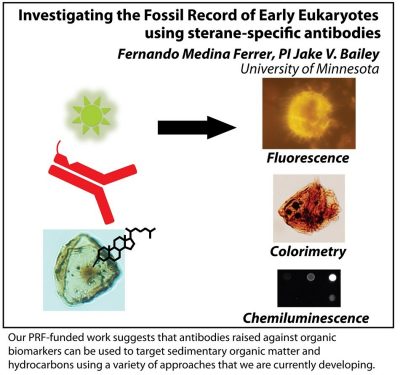
Our PRF-funded work suggests that antibodies raised against organic biomarkers can be used to target sedimentary organic matter and hydrocarbons using a variety of approaches that we are currently developing.
Dr. Jake V. Bailey, University of Minnesota, Minneapolis, MN
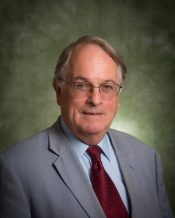
My AC grant on the ionic conductivity in some crystalline clays was my first grant on returning to academia from a 15 year career in industry. We showed that proton motion in single crystal clays was in fact hydronium ions. The student who did most of this work is now a faculty member on the West Bank in Israel. This award led to NSF and DOE awards for me over the next 30 years, and my funding is more active now than ever. PRF is very important to folks getting started as faculty irrespective of their experience level.
I also spent around 6 years on the PRF Advisory Board, when following the 2008 financial collapse we revamped the entire funding scheme placing more emphasis on starting faculty, and on faculty changing directions. I was on the materials sub-committee, and we had the reputation of coming to the review meetings so well-prepared that our work was completed within a day. Many great memories from those days, but a lot of work.
Dr. M. Stanley Whittingham, Binghamton University, State University of New York
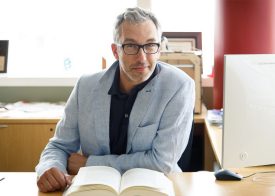
To me, Petroleum Research Fund stands for Hope. I started my job as an Assistant Professor at the University of Houston in 2008. Two years later, PRF's DNI award was the first external grant that I ever got. I still remember receiving the news of it while visiting friends in California, pausing with disbelief: somebody out there is actually going to give me a hundred grand because they liked my idea?! In doing so, PRF did a lot more than just provide much-needed resources to a young Assistant Professor. It injected a dose of enthusiasm and belief in myself right at that two year-mark in my faculty career where self-doubt started to rear its ugly head. Eight years later, I received my second PRF grant, shortly before being promoted to Full Professor. By then, my funding portfolio grew, and the grant seemed a little smaller... But that feeling of "somebody out there thinks we have good ideas" did not: PRF once again reignited our faith in a project that other funders shunned, but that ultimately led to many discoveries. Happy birthday, PRF! May you bring excitement and hope to the researchers young and old in the next 65 years!
Dr. Ognjen J. Miljanic, University of Houston, TX
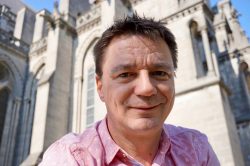
The positive notification about my ACS PRF Doctoral New Investigator proposal is one of the most special moments in my career as PI. It was my first external funding and allowed me to make the transition from University start-up funds to being truly independent. I remember that my department chair took me out for lunch to celebrate that day. This ACS PRF grant marked the beginning of my successful career as scholar and research mentor, and I am thankful for the support I received from ACS PRF.
Dr. Lars C. Grabow, University of Houston, TX
Receiving a Type AC PRF Grant under the purview of the American Chemical Society in 2006, right after earning tenure, turned out to be critical for accelerating my career through the infamous tenure hole, the time after tenure that can easily become a dearth of inspiration and motivation. PRF support fueled a new research project in the lab, entitled “Catalysis by a Large Non-Protein Biopolymer: Dissecting VS Ribozyme Folding, Structure, and Mechanism using Single Molecule Fluorescence and Crystallography”; a mouthful that helped support a former-technician-turned-graduate-student in his quest to develop our first in-house biophysical assays employing single molecule fluorescence microscopy. After a total of almost 10 years in my lab (4 years as a technician), Dr. Miguel Pereira defended his PhD thesis, taking the cake – much to his family’s delight – by showing that a complex RNA enzyme folds hierarchically to reach “down(stream)”, rather than “up(stream)” as previously thought, to grab the site for the self-cleavage needed during the replication cycle of a virus-like parasite found in a bread mold. The PRF-funded work was published in the Journal of Molecular Biology in 2008, demonstrating how Chemistry, Physics and Biology naturally can join forces.
Dr. Nils G. Walter, University of Michigan, Ann Arbor, MI
My first grant as an assistant professor was from the PRF. It helped pay my first graduate students, provided an initial success in proposal writing, and helped launch my career. The results generated from my PRF project on binary diffusion of guest molecules in zeolites played a key role in my getting tenure. I am very grateful to PRF for their support of early career researchers.
Dr. Randall Q. Snurr, Northwestern University, Evanston, IL
I am grateful to the Petroleum Research Fund for providing funds for me as a junior faculty member which helped to jumpstart my career as a physics professor at the University of Rhode Island.
Dr. David R. Heskett, University of Rhode Island, Kingston, RI
Our PRF project supported a young researcher at postdoc level, Dr Dina Vachtman. Dina had done a PhD in geomorphology and this grant helped her to transition to marine geomorphology, which ultimately helped her to get a job with the Norwegian oil company Equinor. Dina explored how the shapes of submarine canyons can be characterised using their hypsometries (area distributions with depth), which was published in the journal Marine and Petroleum Geology. The ACS-PRF support was thus extremely valuable in the development of one researcher and for leading to an excellent published result.
Dr. Neil Mitchell, University of Manchester, UK
I am very grateful for the support that PRF has provided me over the years. These grants allowed me to tackle problems that were not "popular" at the time (e.g. phosphorites) and would not have been supported by the NSF or other institutions. I was also fortunate enough to be selected for service on several PRF review committees, experiences that broadened my knowledge and helped me to understand how grant proposals are evaluated.
Dr. Robert E. Garrison, University of California, Santa Cruz
In 1975, I took up a faculty position as the resident organic chemist at the Vanderbilt Medical Center. My only co-worker was a half-time technician. I added a handful of undergraduates from the Chemistry Department. In 1979, I received a Petroleum Research Fund AC grant. This allowed me to hire a postdoc, who, following up on the work the undergraduates had started, finished the five publications that took me to a tenure-track position at the University of Delaware. He also played a key role in setting up the new lab and getting it operational. That said, I regret that the Petroleum Research Fund has felt to diffuse its efforts across many aspects of organic chemistry. This has been a significant setback to the development of organic synthesis in this country. There is no other source of starter funds for a new idea, to achieve the initial results necessary for NSF or NIH support.
Dr. Douglass F. Taber, University of Delaware, Newark, DE
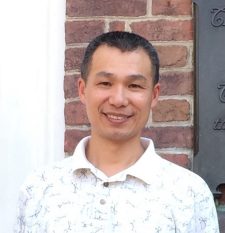
My PRF grant was focused on the study of petroleum fuel droplet vaporization at high ambient pressures. We set up a high-pressure chamber and related optical diagnostic tools to acquire the history of droplet size during vaporization. We have used these experimental data to validate our numerical models; we have also based on the high-pressure chamber to study the phenomena of drop-wall interaction in subsequent research. This PRF grant provided me the very fast opportunity in studying fuel droplet dynamics at a fundamental level. My original research was focused on diesel spray combustion, which is more applied than fundamental. The PRF grant allowed me to delve into fundamental fluid mechanics and produce preliminary results that have helped me obtain a project by the National Science Foundation on multicomponent petroleum-biofuel vaporization study. The experimental facilities also helped me obtain a project sponsored by the Army Research Laboratory on the interactions of high-speed fuel droplets with heated walls. Overall, the PRF grant has been the important seed funding for my research program.
Dr. Song-Charng Kong, Iowa State University, Ames, IA
I finished my Ph. D. in Chemical Physics at the University of Chicago in 1969. At that time, colleges and universities in the United States did not hire women as tenure-track faculty members. I applied for an NRC postdoc at NBS (now NIST), but I was not accepted because they would not make two awards in the same family, and my (then) husband had gotten an award. I did get a six month appointment at NBS, after the intervention of physicist Anneke Sengers. Thinking that I would be unemployed after 6 months, I proceeded with another life goal and had twin boys in 1970. My job at NBS did not end, but instead I moved into a career track. Time passed, the world evolved, and by 1978, the University of Maryland at College Park was trying to diversify its faculty. I accepted a tenure-track position in the UM Department of Chemistry and Biochemistry. The first grant I got as a faculty member was a PRF grant to continue my research on critical phenomena in fluids. That grant gave me the not only the financial support that I needed, but also confidence that I could succeed in academic science.
Dr. Sandra C. Greer, Mills College, Oakland, CA
I am passionate about studying the spatial pattern of exhumation and erosion in active mountains and their change through times. I am using dating techniques applied to bedrock samples and river sands collected in regions such as the Himalaya or the St. Elias Mountains in Alaska. However, looking back in time is restricted with this approach. The seed money from a PRF-ND grant allowed me to study the past of the St. Elias Mountains. I expanded my expertise in dating techniques to Cenozoic sedimentary strata recovered from industry wells drilled in the Gulf of Alaska. We developed a double-dating technique where we combine U-Pb and fission track dating on hundreds of individual detrital zircon grains. This first detrital project allowed me to conduct a source-to-sink study integrating the onland record with offshore data in southeast Alaska. Since then I conducted two more detrital studies in southern Alaska and started a new collaboration with colleagues studying the basin evolution of the Labrador shelf. Through this pilot project we advanced our understanding of the evolution of the western North American margin. More importantly, the new methods that have been developed significantly advance the amount of information that can be gained sedimentary records.
Dr. Eva Enkelmann, University of Calgary, AB, Canada
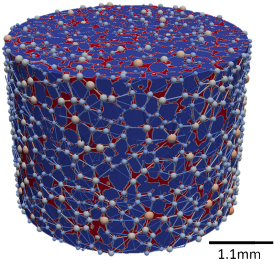
I had an original high-risk idea, whether we can use the X-ray imaging to visualise and evaluate the salinity transport and wettability alteration in rocks. RFP has provided us the great opportunity to explore this fundamental research. The first stage of the work has been successfully completed in collaboration with the project partners from Stuttgart University and Diamond Light Source. The funding allowed us to create absolute new insights into the physical chemical processes in low salinity waterflooding. Additionally, thanks to the funding, we achieved the preliminary goals of the project that will lead to larger research portfolio and provide novel insights into this enhanced oil recovery through low salinity waterflooding. Proposal application for PRF is straightforward with proper review process, which is highly appreciable.
Dr. Vahid Niasar, University of Manchester, UK

I started my career at UC Berkeley in July 2004. I had received sound advice from many other faculty that I admired to ‘get started right away’ with writing proposals etc. One of the first proposals I worked on that summer was a PRF Doctoral New Investigator (DNI) proposal for new faculty. I did not have any preliminary results and, at the time, was only armed with my job proposals. However, I had already decided that the job proposals were overly ambitious, and I needed to start with something reasonable. The proposal I put together was shipped off, and when I did hear back from the PRF, it was a rejection. To this day, that email still haunts me, and my heart skips a small beat when I see an email in my inbox from Nancy Jensen. I was devastated….if I could not garner a grant earmarked for new faculty, what hope did I have moving forward? The reviewers on this first DNI proposal gently pointed out that the idea I had proposed, while workable, was too close to work that I had conducted as a postdoc on divinyl cyclopropane rearrangements to make seven-membered natural products. They encouraged me to differentiate myself from my postdoctoral advisor. In hindsight, this was a key piece of advice as it forced me to apply this lens of ‘too close to previous work’ to everything that I did from then on out. I now constantly strive to do something different to surprise or teach the community something new. I was ultimately successful in obtaining a PRF DNI grant on my second try. I was still infatuated with making natural products that contained seven-membered rings but now sought to use a formal [5+2] enyne metathesis that employed Ga(III) salts as pi-Lewis acids to form the seven-membered rings. This direction of research formed the basis of my research program for the ensuing decade and led to total syntheses of relatively modest Salvia diterpenoids all the way to topologically complex diterpenoid alkaloids. The PRF DNI grant also seeded two ultimately successful NIH R01 grants. Fast forward fourteen years from the start of my career to what I hope are the ‘teenage years’ of my career. Our research group was highly active with many members (approximately 30). We were publishing frequently but also spending fast and drawing down on our research grant support. Ideas emerged constantly from discussions with that large number of individuals and we constantly discarded many worthy ideas (in my opinion) to focus only on the ones that we could afford to work on. It was a deliciously intoxicating time ... not much unlike the situation I now face in my research group. Except, at that time, we had several renewals pending with the NIH and NSF. Well, several of those renewals were not funded, and I was in a position where I had a large group, lots of new ideas that I really liked, and limited funds. The PRF once again came to my rescue. The PRF New Directions (ND) program forced me to propose a new idea that would not only differentiate me from others, but would be a departure from work that my group had pursued in the past. Furthermore, there needed to be a relevance to petroleum research –– a requirement that seemed to have grown in significance since the first time I had applied to the ACS PRF in 2004. The PRF ND challenged me in a good way to think outside my comfort zone. I proposed some work on unusual conjugation involving electron-deficient dienes and cumulenes as well as carbon-carbon bond cleavage chemistry. These two seemingly disparate ideas, which were connected by unusual pericyclic processes, made for a compelling enough proposal that was funded. Many of those early PRF-ND ideas have since blossomed into full-fledged programs in my research group and are the basis of many of the successful directions that my laboratory is now pursuing. I am grateful to the ACS PRF for challenging me by forcing me to think outside my comfort zone and at the same time providing much needed support that came at a critical time for my laboratory. My story is not unique. I am aware of many young investigators (perhaps not at the ‘teenage’ stage of their careers yet like I am) that are just as grateful to the ACS PRF. I am better because of the ACS PRF and its funding programs.
Dr. Richmond Sarpong, University of California, Berkeley

PRF has provided seed funds for my research during several critical moments in my career. The ACS PRF postdoctoral fellowship allowed me to pursue training at Stanford University, where I learned important skills needed for my independent career. Subsequent PRF support came during my faculty position at Bowling Green State University. These funds enabled the collection of preliminary experimental results essential for successful competition for federal funding. Thank you, ACS PRF!
Dr. Ksenija Glusac, University of Illinois at Chicago
I was very lucky to receive two ACS PRF grants during my academic career. The first one was particularly appreciated as it helped me to build my confidence. The results from the first grant also led to a larger industrial grant later. Many students in my group also benefited a lot from the training when conducting these two ACS PRF projects. Happy Birthday, Petroleum Research Fund.
Dr. Luyi Sun, University of Connecticut, Storrs, CT

The ACS PRF New Direction (ND) grant provided me the opportunity to initiate a new research direction in matrix acidizing and acid fracturing. These are essential processes for enhancing oil and gas production in carbonate reservoirs. In the matrix acidizing (Figure 1), acid is injected into the reservoir below the formation fracture pressure resulting in dissolution of carbonate minerals and creating highly conductive channels. In the acid fracturing (Figure 2), a fracture is firstly created in the reservoir followed by acid injection into the fracture and etching fracture surfaces. This process results in fracture conductivity after fracture closure. In modeling these complex processes, one must couple fluid flow, reactive transport, and rock dissolution. We have developed numerical simulators to model matrix acidizing and acid fracturing, respectively. Effects of various geology and engineering parameters on acid stimulation performance can now be investigated based on these simulators. Our modeling efforts can assist engineering designs of acid stimulation operations. My PhD student, Rencheng Dong, has been supported by ACS PRF. Travel support from this grant enabled him to give presentations at several SPE conferences. These conference experiences also helped him improve presentation skills and prepared him for his future career.
Dr. Mary F. Wheeler, University of Texas at Austin
In 2017, my group was fortunate to have been awarded with the ACS Petroleum Research Fund for our research focused in the development of unique functional group interconversions. At the time, my group was situated at the University of Texas Arlington, where a couple of graduate and undergraduate students were supported by this ND grant. For instance, my first graduate student Enrique Barragan received his PhD degree in 2019. He is now working at Nanosyn in California. Another graduate student (Anurag Noonikara) was selected to participate in the 2019 ACS Summer School on Green Chemistry and Sustainable Energy. Besides those two inspiring stories, several of my undergraduate students are now either pursuing PhDs in chemistry or have joined medical school. Regarding to my career; well, besides funding my research plans, we have published several peer-review articles, from which three of them have been featured on front covers of their respective journal/issue. Honestly, I cannot be prouder of those pieces of work and of course the students that made it possible. Currently, my group is at Florida Gulf Coast University kicking it strong, still with PRF funds.
Dr. Alejandro Bugarin, Florida Gulf Coast University, Fort Myers, FL
The ACS Petroleum Research Fund New Directions grant awarded gave me the opportunity to move into a new area of research. The hallmark of my work was on developing methodology and studying the dynamics of supramolecular systems in aqueous solution from a very fundamental point of view. I decided to move to studies on the dynamics of small molecules in hydrogels, which are viscoelastic materials with broad applications from oil recovery to drug delivery. This new direction broadened my outlook and expertise. The seed funding provided by the ACS-PRF grant for fundamental studies provided my students opportunities to participate in training programs that involve the interactions with industry.
Dr. Cornelia Bohne, University of Victoria, BC, Canada
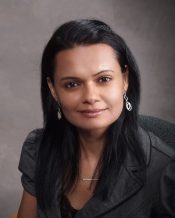
PRF has impacted my career by many magnitudes. I was an Assistant Professor in a teaching-heavy undergraduate department at a PhD institution. Due to limited research resources, I reinvented myself as a scholar. I started “dabbling” into new a research area. I transitioned from studying cell membrane interactions to studying the phase change heat transfer on enhanced surfaces! I submitted a new directions PRF grant knowing that my new idea will benefit the petroleum industry by lowering the energy costs by reducing the heat required in chemical separations of the petroleum components. I am grateful to ACS to recognize my research idea, efforts and most importantly, reviving my research career! This grant provided me the much-needed visibility on the job market and landed with a faculty position in a PhD-granting department at a public research institute. I am also thankful to the program director for allowing me to transfer the grant to my new institution. The funds from this grant has led to some interesting work that recently got accepted in Scientific Reports and will soon be featured on the cover of Advanced Engineering Materials. A big thank you to ACS PRF program to revive and jump-restart my research career!
Dr. Anju Gupta, University of Toledo, OH
I learned about the ACS Petroleum Research Fund soon after I took up a faculty position in the chemistry department at Columbia University. That was 59 years ago! Encouraged by senior faculty colleagues, I took a deep breath and submitted a proposal to PRF for support of my research on inorganic electronic structures and reactions. The grant was a game changer; it funded a postdoctoral scholar who played a key role in our research on metal complexes in unusual oxidation states, which in the years following became a booming field. Indeed, compounds of metals containing “noninnocent ligands” have made a huge impact on work in materials science as well as in green chemistry and catalysis. Thanks to PRF, my group and I were able to explore an exciting new area of synthetic inorganic chemistry. In recent years at Caltech, I have urged my young colleagues to submit proposals to PRF, and from time to time I have served as a reviewer. Early in the 21st century, my group became deeply involved in renewable energy science. We had preliminary evidence that the metal-oxide electrocatalysts developed for water oxidation might oxygenate inert hydrocarbons if the reactions were performed in aprotic solvents. Could I ask PRF for support again? Amazingly, over 50 years after my first grant, PRF bet on me again. With this support, I have launched a program that includes work on cobalt/molybdenum electrocatalysts for activation of inert molecules. With deep appreciation for PRF leadership in the chemistry enterprise, I join colleagues in celebrating the 65th anniversary of your very successful grants program.
Dr. Harry B. Gray, California Institute of Technology, Pasadena, CA

Many heterogeneous chemical reactions catalyzed over solid surfaces at operating temperatures are used to transform raw materials into products such as, (bio) energy, food, healthcare products and chemicals for human benefit. Metal oxides and supported metal nanoparticles are used as heterogeneous catalysts to speed up the reactions. These catalytic reactions are dynamic processes and take place at the atomic level, with active structures forming during reactions. However due to limitations of the instrumentation and lack of direct evidence, the nature of the chemical catalytic reactions at the fundamental atomic level was completely unknown. Professor Pratibha Gai, (with Prof E D Boyes), carried out the development of the world’s first atomic resolution-environmental transmission electron microscope (atomic resolution-ETEM) for visualizing and analyzing dynamic catalysis at the atomic level, thus revolutionizing the chemical sciences and creating new knowledge. Her development has led to new areas of research and used globally by researchers, chemical companies and electron microscope manufacturers. Prof Pratibha Gai received the ACS PRF award for scientific education (ACS PRF 30284-SE) which enabled her to disseminate her research internationally. She gratefully acknowledges the receipt of the ACS PRF award.
Dr. Pratibha Gai, University of York, UK
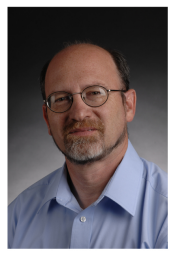
The Petroleum Research Fund (PRF) had a profound impact on my early years as a researcher. Thirty years ago the start-up packages in my department (which had just made the transition to a fully research-active faculty) were woefully inadequate to set up a laboratory, much less purchase the instrumentation necessary for characterization in a modern synthetic lab. Thanks to the generosity of PRF in awarding one of my very first grants, I was able to purchase much-needed instruments and supplies that allowed me to do the kind of research that I had envisioned in those early days. I will always be grateful for my PRF grants!
Dr. Dominick J. Casadonte, Jr., Texas Tech University, Lubbock, TX
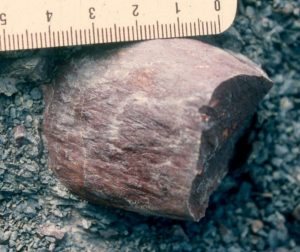
Support from PRF provided geologic field logistics, on two separate occasions, for examination of the depositional systems involved in Paleozoic rocks (Devonian, Carboniferous and Permian) in Bolivia. Three PhD dissertations resulted from the grants, with each yielding refereed publications. Among these (through palynology) was the discovery that the Late Paleozoic Ice Age (LPIA), thought to begin in Carboniferous time, actually began in the Late Devonian, confirming data from eastern Brazil. The event in Bolivia is documented by beds of glacially-produced diamictites, with allochthonous and striated clasts (see picture) of broad compositions and sizes. Further, the glaciation caused a significant sea level drop, eutrophication of shallow seas, and contributed to the Late Devonian mass extinction event. These rocks were highly enriched in organic carbon and became important petroleum source rocks globally. PRF support also permitted study of post-glacial systems with fluvial outwash systems (Carboniferous), yielding to eolian sands. These in turn followed by a well-known carbonate system. This latter succession was punctuated by sequence boundaries that we were able to relatively date with palynology (and other microfossils) and correlate to global sea level fluctuations. Finally, with Brazilian and Argentine colleagues, we proposed clockwise rotation of Gondwana from high- to low paleolatitudes.
Dr. Peter Isaacson, University of Idaho, Moscow, ID
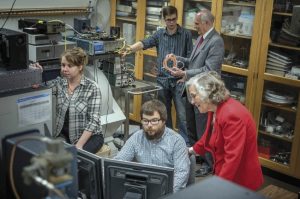
My first research grant, PRF 2713-G3, “Interactions between non-equivalent unpaired electrons,” started my exploration of ideas that I had been told were too difficult for a beginning assistant professor to undertake. With this PRF grant we produced many discrete complexes containing a transition metal and a nitroxide radical, and characterized them with continuous wave EPR. PRF 13071-AC6, “Time domain EPR studies of interacting spin systems,” facilitated venturing into pulsed EPR measurements of the relaxation times of these metal-nitroxide radical systems. We built a pulsed EPR spectrometer and measured the T1 and T2 relaxation times. A subsequent PRF grant 22588-AC3, “Active site water in metallobiochemistry,” allowed us to characterize the ligand environment of Co(II) substituted into carbonic anhydrase. Building on this foundational support from PRF, we obtained NIH and NSF support. We made EPR quantitative, developed EPR imaging, focused researchers on insights provided by time domain EPR, and, most recently, revolutionized EPR by developing rapid scan EPR as a new way to enhance signal-to-noise. Now, 49 years after submitting the first grant proposal we continue exploring new ways to view the natural world via electron spins. We create new methods of studying spins and build the instruments to implement the methods.
Dr. Gareth R. Eaton and Dr. Sandra S. Eaton, University of Denver, CO
PRF funding that I have received over the past 20 years has substantially contributed to advancing the science, careers and education of five female scientists. In my early, pretenure career, PRF (2001, 2005) funding allowed me to expand my research focus, which is rooted in stable isotope analyses for paleoceanographic reconstructions, to work on foraminiferal Mg/Ca ratios as a paleothermometer and sea level proxy (Billups and Scheiderich, 2009) as well as nannofossil Sr/Ca ratios as a productivity indicator (Waite et al., 2008). Further grants in 2010 and 2016 focusing on nitrogen isotopes as a tracer for marine primary productivity (Billups et al., 2012) and amino acid racemization in paleothermometry (Millman et al., manuscript in preparation), respectively, provided continued support for my research activities. Looking back, I would like to highlight the significance of PRF funding not only on my career, but also on that of the students in my research group. These grants funded three Master’s Theses (Kathleen Scheiderich 2004, Amanda Waite 2005, Emily Millman 2019) and one post-doctoral advisee (Dr. Rebecca Hays, 2010). K. Scheiderich and A. Waite continued in PhD programs and are now researchers at the USGS, Ca, and the ANGARI Foundation, Fl, respectively. E. Millman is currently in a PhD program in St. Louis. Dr. R. Hays remained in academia accepting a tenure track position at Eastern University in 2011, where she is currently an Associate Professor. Undoubtedly, funding from the PRF has been instrumental in the professional development of these students and myself.
Billups, K., and K. Scheiderich, A synthesis of Late Oligocene through Miocene deep sea temperatures as inferred from foraminiferal Mg/Ca ratios, Int. Assoc. Sedimentol Spec. Publ. 42, 1-16, 2009.
Waite, A., L. Diester-Haass, S. Gibbs, R. Rickaby, and K. Billups, A Top-down and Bottom-up Comparison of paleoproductivity proxies: Calcareous Nannofossil Sr/Ca Ratios and Benthic Foraminiferal Accumulation Rates, G-Cubed, 9, doi: 10/1029/2007GC001812, 2008.
Billups, K., Aufdenkampe, A., R. Hays, Late Miocene through early Pleistocene nutrient utilization and export production in the Antarctic Zone of the Southern Ocean, Global and Planetary Change,
http://dx.doi.org/10.1016/j.gloplacha.2012.11.014.
Dr. Katharina Billups, University of Delaware, Newark, DE
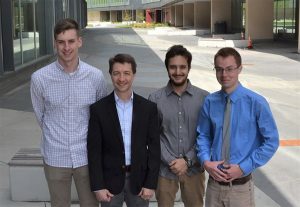
The Allgeier Research Group at the University of Kansas (KU) is a new awardee (2020) of an ACS-PRF grant and excited to join the long tradition of excellence embodied in grantees. Inspired by the Kansas state motto Ad Astra per Aspera (through hardship to the stars), we will bring a pioneer spirit to diligently develop new understanding of kerogen and develop physical methods for characterization of the same. The grant will support a graduate researcher and indirectly give opportunities to undergraduate and high-school students to engage in scientific activities. At the same time, it will be critical to launching a dynamic academic group in the KU Department of Chemical and Petroleum Engineering. We recognize that the grant received is a sign of trust and we will give our best to meet the expectations and contribute with our findings to the energy field. We are thrilled by the future challenges and feel ready to be part of the solution. Happy birthday PRF, we are glad to see that these last 65 years were well-lived, and we wish you many more to come. From a strong tradition to another, the Jayhawks say: Rock Chalk!
Dr. Alan M. Allgeier, University of Kansas, Lawrence, KS
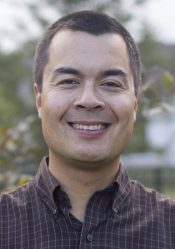
My group has been fortunate to have received two grants from the PRF, a new investigator grant, from a proposal submitted literally days after starting my independent career, and a new directions grant, from when I was considerably more seasoned. Both grants kickstarted projects that went on to be successfully funded by federal agencies, and as such their impact extended far beyond their original funding periods, supporting many graduate and undergraduate students. Funding from the PRF gave us opportunities to move into new areas which have turned into our current areas of expertise (molecular folding and out-of-equilibrium assembly). It's hard to know where we would be without this support; at best it would have been a much rockier road to a similar destination, but I suspect we'd be doing something very different and ultimately much less satisfying.
Dr. Scott Hartley, Miami University, Oxford, OH
PRF type G and AC research grants played a critical role in launching my academic career as an assistant professor interested in basic science problems related to physical organic chemistry and mass spectrometry. They then helped sustain it over the years as I rose through the ranks to my current position in the Department of Chemistry at the University of Minnesota as the L. I. Smith Professor of Chemistry. ND awards enabled new research directions to be explored and the investigation of organocatalysts with multiple hydrogen bonds and charge-center activation to be realized. Thanks PRF, and happy 65th anniversary! You play a unique funding role that nurtures young faculty and sustains research endeavors occurring in institutions spanning from small undergraduate colleges to large Ph.D. granting universities.
Dr. Steven R. Kass, University of Minnesota, Minneapolis, MN
The invitation to comment on the impact of the ACS PRF on my research program as part of the symposium celebrating its 65th anniversary prompted a very pleasant remembrance of the most exciting time in my career. As a senior graduate student at the ETH-Zürich, I wrote a PRF Type G grant to help fund a project as part of my new assistant professorship at the University of Illinois. The grant was submitted in April 1980 and I arrived in Urbana in mid August. I shall never forget the day I arrived, brimming with excitement about the start of a lifelong dream to be a chemistry professor. On that day I was given a key and a mailbox which, much to my surprise, already contained an envelope from the ACS PRF addressed to Dr. Scott E. Denmark. I hurriedly opened it to find a letter from Justin W. Collat dated June 9, 1980 informing me that my application (#12649-G1) had been awarded! On the next day, I met with the Head of Department and proudly showed him this letter. My excitement was short-lived however as he commented, “Well, that’s $10,000 of start-up funds I won’t have to give you”. Fortunately, my senior organic chemistry colleagues prevailed and I did get the whopping $40,000 he promised.
Dr. Scott E. Denmark, University of Illinois at Urbana-Champaign
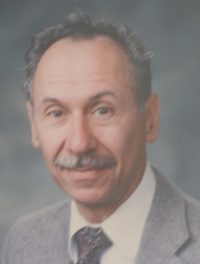
I am grateful for PRF grants that supported our research exploring fundamental aspects of organic reactivity. A 1982 grant, "Critical Assessment of Stereoelectronic Control," led to iconoclastic publications "Absence of Stereoelectronic Control in Hydrolysis of Cyclic Amidines" and "Hydrolysis of Unsymmetrical Acetamidines: Leaving Abilities and Stereoelectronic Effects" in JACS 1986, 108, 5997 and 1987, 109, 522. My coauthor was Oswaldo Nuñez, a graduate student from Venezuela. With further publications this research eventually led to a review, "Is There Stereoelectronic Control in Formation and Cleavage of Tetrahedral Intermediates?", in Acc. Chem. Res. 2002, 35, 28. A 2008 grant, "Reactions of p-Benzynes with Nucleophiles," allowed us to address a new area of research and explore a new reaction that we had discovered, namely nucleophilic addition to a diradical, leading to publications "Reactivity of Nucleophiles toward a p-Benzyne Derived from an Enediyne" J. Phys. Org. Chem. 2013, 26, 206, and "Selectivity and Isotope Effects in Hydronation of a Naked Aryl Anion" JACS 2014, 136, 15263, where we could distinguish between an organometallic and an aryl anion, a long-postulated intermediate that is notable for its high reactivity and unselectivity. My coauthor was Gabriel Reyes-Rodriguez, a graduate student from Puerto Rico. I am also grateful for PRF support of the 16th International Conference on Physical Organic Chemistry, sponsored by IUPAC. In August 2002 it was held on the UCSD campus, in La Jolla, CA, and it attracted 280 chemists from 30 countries.
Dr. Charles L. Perrin, University of California, San Diego
The impact of this grant on my research program and my career is unmistakable. I lead a multidisciplinary team, with research lines that include the development and mechanistic understanding of tunable oxidation catalysts, uncovering the role that biometals play in modulating the structure and function of neuronal proteins, and probing how intracellular metal redox homeostasis contributes to bacterial virulence. The central theme connecting these efforts is to understand and harness the chemical capabilities of transition metals for the benefit of society. I’m only in the first year of my PRF-ND grant, but these funds have already helped me to train both graduate and undergraduate students alike, boosting them on their career paths. Support from the ACS PRF has been essential in ensuring that I could pursue all threads of my research passions, not only contributing to the ACS PRF goals of advancing scientific education and basic research efforts, but doing so while weaving a cohesive story that draws the attention of the wider scientific community and inspires/motivates young scientists who are the future of chemistry research and who will shape the future of our world.
Dr. Heather R. Lucas, Virginia Commonwealth University, Richmond, VA
Under the support of the ACS PRF new-direction grant, the PI has explored the use of metal-organic frame (MOF) for photocatalysis. During the two-year project period, we investigated the advantages and disadvantages of MOF photocatalysts. This will guide the design of better MOF photocatalysts. Also, the results generated in the ACS PRF project are lay a foundation for future proposals to federal funding agencies. In addition, a postdoctoral fellow was trained during the project period. The knowledge and experience that the postdoctoral fellow gained from the project has paved a new avenue for his career. After that, he got a new job of scientist in a federal laboratory. In short, the ACS PRF grant has boosted a new research direct in the PI’s lab and helped the career of next-generation researchers.
Dr. Nianqiang (Nick) Wu, University of Massachusetts Amherst
The New Directions grant allowed us to explore the effects of temperature-dependent thermal properties of rocks on conductive heat flow and geothermal gradients in sedimentary basins. Most of our research is on volcanic rocks, so this application has broadened the horizons of everyone in our research group. This award has supported research by three different PhD students. Jesse Merriman co-wrote the original proposal, and measured thermal properties of carbonates for this project. Jesse's PhD (2019) was mostly on thermal properties of metamorphic basement rocks, and lithospheric geotherms from the Archean to the present day. Stuart Kenderes, who measured the thermal properties of several different shales from the Illinois Basin for this project, is doing a PhD on the emplacement of silicic lava flows. Brenna Halverson, who is doing numerical modeling of the thermal effects of salt diapirs in sedimentary basins, is doing PhD research on the rheological properties of the 2018 Kilauea lava flows. All three students have greatly appreciated both the support, and the opportunity to study topics outside their normal focus.
Dr. Alan Whittington, University of Texas at San Antonio
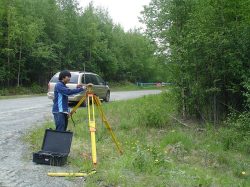
Support from the PRF fund has allowed faculty and students at the University of Texas at El Paso to study the deep geophysical structure of the petroleum producing region of Upper Cook Inlet of Alaska. It funded the work of two PhD students, allowed 4 MS level students to assist in field studies and is the basis of continued PhD and MS level research within the region. Over 4 papers have been published based on data collected during this grant. The photograph shows doctoral student Niti Mankhemthong, now a professor at Chiang Mai University in Thailand, collecting data during his 2009 field campaign.
Dr. Diane Doser, University of Texas at El Paso
The PRF was the first successful proposal in my independent career, and provided valuable funding at the beginning of my research program. Since then the PRF has been very supportive my evolving research interests. In my experience a PRF grant is an excellent conduit into new fields of research for both new and experienced investigators, playing a key role in advancing innovation as well as providing support for graduate students and supplies to explore new ideas.
Dr. John D. Chisholm, Syracuse University, NY
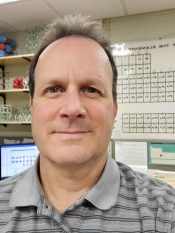
My ACS-PRF New Directions award several years ago was research lifeline. It provided key funding and flexibility to develop a new research area. It was awarded at just the right time as federal funding was increasingly difficult to secure. It is possible that my research program may have folded without ACS-PRF support at that time. Several students from diverse and underrepresented backgrounds benefited from this grant support and after obtaining their doctoral degrees, they started productive independent careers in academics and national laboratories. Critical thinking about on the chemical connections between petroleum/energy and catalysis in that ACS-PRF grant proposal continue to guide some of my current research directions. I am very thankful that the ACS-PRF grant program has established a long 65 year history of providing high impact seed grant funding for the chemical sciences.
Dr. Edward G. Gillan, University of Iowa, Iowa City, IA
Over the years from 1985 to 2008, I received support for my research from five separate awards from the Petroleum Research Fund. The titles of the proposals reflect the evolution of my research and understanding of the general problems of structural styles of sedimentary thrust belts and the relation to petroleum resources. That progress is a direct result of the PRF-funded research. Each of these awards supported graduate research assistants, who were directly involved in the research. Initially, the emphasis was on the sedimentary filling of foreland basins that subsided in response to thrust loads. A subsequent emphasis focused on lateral ramps, on cross-strike alignments of lateral ramps along transverse zones, and ultimately on the geologic controls on transverse zones in thin-skinned thrust belts, leading to the recognition of the importance of basement faults beneath the allochthon. The later work turned to the mechanical properties of the stratigraphic units that control the geometry of frontal and lateral ramps, particularly to the evolution of thick massive ductile duplexes (mushwads) in thrust belts and associated thermal anomalies. Ultimately this academic research led to practical application and the discovery of the Big Canoe Creek shale gas field in a mushwad.
Dr. William A. Thomas, University of Kentucky (Emeritus), now Visiting Scientist, Geological Survey of Alabama
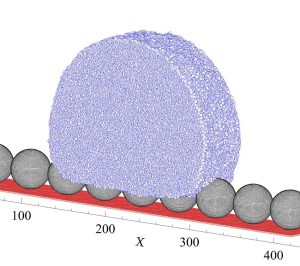
The PRF New Directions grant “Modeling of the Contact Angle Hysteresis and Wetting Properties of Oil Droplets on Textured Surfaces” addresses important issues in the transport phenomena of polymeric liquids at structured and deformable interfaces. The results of simulations are useful for an optimal design of self-cleaning and nonfouling surfaces, novel porous filters, and modeling dewetting and stability of thin polymer films. In particular, Nikolai Priezjev and his MS student Anish Thomas have recently studied the dynamic behavior of a partially wetting polymer droplet driven over a rough surface composed of a periodic array of spherical nanoparticles. Using molecular dynamics simulations, they showed that at sufficiently small values of the external force, the droplet remains pinned at the particles' surface, while above the threshold, its motion consists of alternating periods of pinning and rapid displacements between neighboring particles. The latter process involves large periodic variation of the advancing and receding contact angles due to attachment and detachment of the contact line. Figure. Partially wetting polymer droplet at structured interface.
Dr. Nikolai Priezjev, Wright State University, Dayton, OH
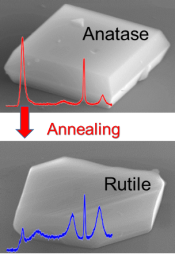
The ACS PRF New Investigator award supported me to establish my independent research in surface catalysis as an assistant professor. This seed fund supported one graduate student and we published 7 peer-reviewed publications in prestigious international journals. The support also is the foundation for my additional NSF awards. Imaging reactions in action at the heterogenous interface is the key to understand reactions between molecules and surfaces. The catalytic activity of reducible oxides is often dominated by surface defects. Employing carboxylic acid, acetone, and formaldehyde as probing molecules, we studied how reactive sites affect the chemical activity of a model single crystal samples oxide, specifically TiO2, using scanning tunneling microscopy at the atomic level. After tenure, a current ACS PRF New Direction award enables me to expand my research from imaging reactions on model single crystal samples using surface science techniques which operate in UHV and at low temperature to studying high-surface-area industrial catalysts in an innovative environment-controlled reaction cell which operates at high pressure and high temperature. The goal is to directly correlate reactivities with various crystal facets in different polymorphs of individual micro-sized oxide crystals. Figure: Phase transition of an individual micro-sized TiO2 crystal.
Dr. Zhenrong Zhang, Baylor University, Waco, TX
I am thankful that I was able to secure an ACS-PRF grant shortly after I began my career at Brooklyn College/CUNY. As of that point in time, the thermodynamic stability of the chlorite group of minerals in hydrothermal solutions between 25 and 300 °C had not been experimentally investigated. Obviously, the relative sluggishness of reaction rates of silicate minerals under low temperature conditions contributed to this knowledge gap. Nonetheless, chlorite neoformation and diagenesis exercise significant effects on the petrophysical properties of siliciclastic petroleum reservoirs, and underscored the need to address this knowledge gap. Besides questions pertaining to reaction kinetics, significant questions had also been raised as to whether complex aluminosilicates of variable compositions are disequilibrium solids rather than true thermodynamic phases. In the former instance, solution equilibration measurements of such minerals would yield irrational solubility data. Clearly, these were basic and fundamental questions about this major mineral group, and the funding provided by the Petroleum Research Fund enabled us (Aja & Small, 1999; Aja & Dyar, 2002; Aja et al., 2015; Aja, 2002, 2019) to contribute to the resolution of these fundamental questions on chlorite - aqueous solutions interactions that are directly applicable to conditions in siliciclastic petroleum reservoirs.
Dr. Stephen U. Aja, City University of New York, Brooklyn College
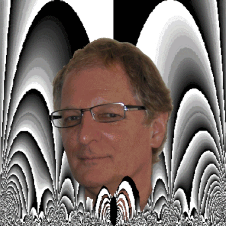
As a Chemical Physicist, most of my over 50 years of research has focused on topics where physics and chemistry overlap, but in my case this has been, except for the work initially supported by the PRF, more on the physics side, rather than the chemical. These areas have included development of novel theoretical and computational approaches to Electron-Atom Scattering and the properties of Atoms in Strong Laser Fields; Chaos Theory; use of ideas from Quantum Chemistry, rather than Many-Body Quantum Physics, to explore the dynamics of coherent atomic Bose-Einstein Condensates at 10-12 K; and finally work in Applied Mathematics as it relates to more than 15 years of work on the NIST Handbook of Mathematical Functions. But in the midst of all this, I and my research groups, these involving more than 100 undergraduates, graduate students, postdocs, and faculty colleagues, have twice been drawn into trying to understand problems, which are definitely chemistry! This would not have been possible without “starter grants” from the PRF, for which I am enormously grateful, and which, once started, grew into support from many other sources. The first of these involves intra-molecular energy flow on the pico-second time scale, and is well illustrated by a series of papers beginning with: J. S. Hutchinson, J. T. Hynes, and W. P. Reinhardt, "Quantum Dynamic Analysis of Energy Transfer in Model Hydrocarbons." Chem. Phys. Letters, 108, 353-358 (1984), and which cites PRF support. And ending, about 8 papers later, with an invited Plenary Faraday Symposium Lecture, as summarized in: Csilla Duneczky and W. P. Reinhardt, "Is There Chemically Significant Trapping of Vibrational Energy in Localized and Chemically Identifiable Moieties?" J. Chem. Soc. (London), Trans Faraday Soc. II, 84, 1511 (1988). This work leads to the conclusion that with the exception of very simple and unusual chemical systems, the assumptions of rapid dispersal of internal vibrational energy within simple molecules, leading to statistical theories of uni-molecular reactions, will suffice in most cases. The vibrational spectroscopy is, of course, a quite different issue, as it often clearly shows the early time ultra-fast dynamics of the excitation of a single chemical bond. Our second detour grew out of work on Chaos Theory, and the recognition of the existence of very old adiabatic invariances, dating back to the early, pre-quantum era of the 20th Century, and the work of Poincaré and Hertz. This is well illustrated in the first PRF supported paper in this area: W. P. Reinhardt and J. Hunter III, "Variational Path Optimization and Upper and Lower Bounds to Free Energy Changes via Finite Time Minimization of External Work." J. Chem. Phys. 97, 1599 (1992), Letter to the Editor, and which cites PRF support. Leading onwards, about 10 Papers later, to the Review: W. P. Reinhardt, Mark A. Miller, and Lynn M. Amon, “Why is it so Difficult to Simulate Entropies, Free Energies and Their Differences?” Accts. Chem. Res. 34, 607-614 (2001). This work is featured on the cover of that issue. Thanks to the PRF, and its supporters and donors, from myself, and the many other researchers who have been able to initiate new work, to turn corners into new areas, without having yet obtained support from more traditional granting agencies. Keep up your good works!
Dr. William P. Reinhardt, University of Washington, Seattle, WA
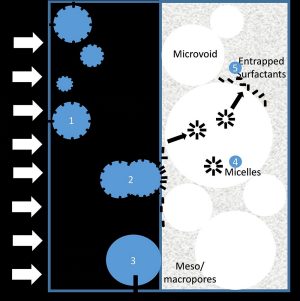
This ND PRF award influenced immensely the career path of three doctoral students in my group. The first doctoral student, Dr. Nicholas Teo currently at 3M, helped develop the central idea of this research while he was working on emulsion-templating of high surface area organogels produced from syndiotactic polystyrene (sPS) and polyimides (PI). These organogels provide high specific surface area, a porous network of cylindrical polymer strands of diameter 50 nm, and combinations of macrovoids of diameter 50 m and mesopores of 2-50 nm diameter. The surface energy of the polymer can be tuned to the HLB values of the surfactants to break oil-water emulsions and separate water and oil phases. The second doctoral student, Ms. Akshata Kulkarni, developed an oil-water separation rig by cleverly constructing a 3D printed polymer support structure for the usually weak organogel so that pressure-driven flows through the organogel could be implemented for continuous oil-water separation.
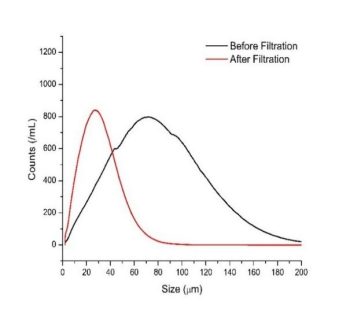
A third doctoral student, Ms. Kaitlyn Mawhinney, expanded the scope of emulsion-templating method to polyurea system, an organogel with surface energy in between sPS and PI. Ms. Kulkarni achieved more than 90% single pass efficiency in separation of micrometer size water droplets from an emulsion with ultra-low sulfur diesel. Figure 1. (Above) Schematic showing coalescing filtration of water droplets from emulsion in oil. (1) Stabilized water droplets. (2) Removal by surfactants by porous polymer phase. (3) Coalesced water droplets settle. (4) Micelle formation in oil phase. (5) Some surfactants remain trapped in mesopores of the polymer. Figure 2. (Right) Water droplet size distribution before and after single-pass through sPS organogel.
Dr. Sadhan C. Jana, University of Akron, OH
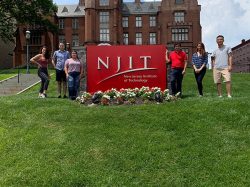
The PRF award had an important impact in the research of my group. It allowed us to write a computer code to identify clathrate cages inside which gas molecules can be trapped. This code has allowed our group to study gases in solutions and it is being used by the broader community as it is available as an open source code (Computer Physics Communications 244:385, 2019). In the words of one undergraduate student:
"I will be forever grateful for the chance you took on by taking me as an undergraduate researching intern last summer - what I learned in those 10 weeks has helped me grow my computational skills, my writing, and my confidence as a learner and researcher.... I officially graduated this May, and I will be staying at NJIT to start my Master's in Chemistry this fall."
This student as well as the PhD student that supervised her were funded by the award. The other PhD student funded by the award published a paper with the undergraduate student he supervised during the summer (J. Phys. Chem. B 122:5557, 2018). Both PhD students are working as Postdoctoral Fellows at NYU and Albert Einstein College of Medicine.
Dr. Cristiano Dias, New Jersey Institute of Technology, Newark, NJ
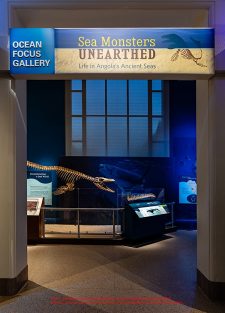
The Petroleum Research Fund provided initial funding for Projecto PaleoAngola, a multidisciplinary, multinational effort begun in 2005 with the goal of understanding the rocks and vertebrate fossils of Angola. The study has focused on the Cretaceous opening and growth of the South Atlantic Ocean, origin and development of the Benguela Current, biogeography of marine organisms, effect of changing paleolatitude on marine and continental paleoecology of Africa, and discovery of fossil vertebrates. 25 articles published thus far, document new marine vertebrate fossil taxa, large scale tectonically driven patterns, and provide the first radiometric dates along the southern Angolan coast, which in turn anchor stable carbon isotope stratigraphy and magnetostratigraphy for refined chronology of the fossils. Additionally, stable oxygen isotope measurements provide a record of sea surface paleotemperature and allow evaluation of body temperatures in marine reptiles, and stable carbon isotope were used to evaluate their foraging ecology. Four Ph.D. and two M.S. students have been mentored in this project and well over 100 undergraduates have been employed in the laboratory. An exhibit, “Sea Monsters Unearthed: Life in Angola’s Ancient Seas,” opened in the Smithsonian Institution in 2018. In 2022 the exhibit and the fossils will return permanently to Angola.
Dr. Louis L. Jacobs, Southern Methodist University, Dallas, TX
The American Chemical Society Petroleum Research Fund provided the opportunity for my group and I to explore a radically New Direction aimed at performing organic synthesis at the ultra-small scale. Miniaturization of materials is a driving force of industry, but chemical transformations of petroleum-based starting materials at the smallest scales remains difficult. We had a radical idea to use high resolution microscopy techniques in combination with selective organic transformations to enable chemists to control and manipulate matter with unprecedented precision. The New Directions program is a rare funding mechanism by which PIs can expand the scope of their research and reach out into new scientific territories. This, in turn, provides novel training opportunities for students and advances fundamental chemistry research by seeding new high risk projects. Since the notification of this award the students (and PI) working on the project have been invigorated and this has catalyzed significant progress and breakthroughs. Certainly a turning point in our laboratory's trajectory!
Dr. Alexander R. Lippert, Southern Methodist University, Dallas, TX

This work was done in collaboration with Dr. Líney Árnadóttir, a new Assistant Professor at Oregon State University. It provided research-based outreach to a smaller regional university, and guidance for the early-career development of this promising young female engineer. It paid for the first student in her group, thus helping her build up her research program. This was my first grant for purely theoretical research, thus adding an important new component to my own group. I asked Prof. Árnadóttir to comment on how this grant impacted her program, and she wrote: “In my second year as an Assistant Professor, I received PRF funding through a collaboration with Charlie Campbell at the University of Washington. This helped me support my first Ph.D. student and to establish myself as a researcher in a new area through mentorship and collaboration with Prof. Campbell. The two papers we published from this project are some of my most cited papers, and I have given numerous invited talks on the topic. This helped me build a strong network of colleagues and collaborators across the country. This accelerated start, which would not have happened without this PRF funding, has had a great impact on my career.”
Dr. Charles T. Campbell, University of Washington, Seattle, WA
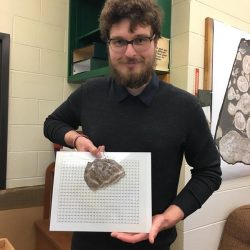
The PRF grant has enabled us to begin diving into an almost forgotten paleobotanical treasure trove: coal balls—a waste product of coal mining in the previous century. Coal is compacted and carbonified plant material, deposited in peat swamps, often hundreds of millions of years ago. Occasionally, carbonate nodules (now found as coal balls) formed in the original peat material, protecting it from becoming compressed and coalified; thus, exquisitely preserving plant tissues in three-dimensional cellular detail. The late Professor Tom Phillips collected the largest coal ball collection in the world and, with his co-workers, made hundreds of thousands of coal ball peels and microscopically investigated close to a mind-boggling 1,000,000 cm2 of peel surface. These researchers tabulated what tissues they saw, in which plant organ, and from which plant taxon, as well as whether or not the material was charred in a wildfire. To unlock the secrets in Phillips’ amazing dataset, the first step of our project is to re-digitize several cubic yards of continuous-form computer print-outs—generated on an IBM360 mainframe computer in the 1970s and early 1980s—containing summary tables of Phillips' data. This will require a huge transcribing effort for which we will employ undergraduate students this summer and fall. The PRF grant allows us to hire students within Biology Scholars Program, which is one of UC Berkeley's initiatives to increase research participation among underrepresented minorities and undergraduate students from under-resourced backgrounds. So far, the most unexpected aspect of our project was the discovery of about half of Phillips' raw data, 'fossilized' on 355 fourty-year-old 8" floppy disks, leading us down a path of computer archaeology and collaboration with vintage computer experts to retrieve these important data. Figure: PhD student Ben Muddiman showing a coal ball peel on top of grid paper.
Dr. Cynthia V. Looy, University of California, Berkeley
My PRF-G grant was so confidence-inspiring! The best $15,000 ever. We used it to generate some data and go after NSF money to study rodlike polymers. That support lasted about 34 years! At mid-career, I got PRF-AC support for a new initiative. This too led to NSF support. We received another AC for polyelectrolytes. It let us make some of the world's best, and will lead to better fundamental studies of this interesting class of polymers. In summary, PRF has been so helpful to me personally, and it enabled many young scientists to train too.
Dr. Paul S. Russo, Georgia Institute of Technology, Atlanta, GA
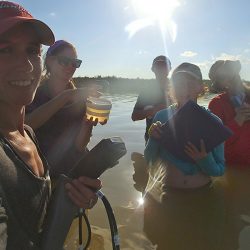
My PRF New Directions Award in 2015 supported my research as an early career scientist helping pave my way toward tenure (awarded this year!) and provided a foundation for two master theses and an international field experience for 2 undergraduate and 2 graduate students. Both graduate students who completed their theses are pursuing doctoral degrees in other prestigious programs. The award supported a collaboration to study the formation and early diagenesis of microbialites in Storr’s Lake on the island of San Salvador in The Bahamas. We combined field-based work with calcium and magnesium stable isotopic analyses. Storr’s Lake is an accessible, turbid, hypersaline alkaline lake with microbiological assemblages forming carbonate microbialites – including thrombolites and stromatolites. This international collaborative research experience supported by the PRF initiated a relationship with an established field station on a remote Bahamian island, serving as the impetus to proposing an international field experience and Education Abroad program at my current institution. The first trip with students this past spring affirmed that this location and its unique geological setting will continue to enrich our students educational experience and broaden our understanding of biogeochemical processes today and in Earth’s past.
Dr. Elizabeth M. Griffith, Ohio State University, Columbus, OH
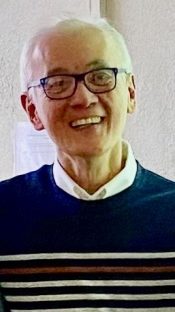
Happy birthday Petroleum Research Fund. The PRF grant I received more than 40 years ago got me started on the path to investigate the properties of biological nonheme iron centers that carry out challenging oxidations such as the hydroxylation of methane and other molecules with strong C–H bonds. Our achievements in high-valent iron-oxo chemistry could not have been realized without your timely infusion of funding that got a young chemist started in his independent research career. Best wishes for a bright future in encouraging young scientists.
Dr. Lawrence Que Jr., University of Minnesota, Minneapolis, MN
My dissertation mentor (Graham Underwood at NYU Graduate School of Arts and Sciences [GSAS]) had a PRF grant for new faculty that supported me for my research (1970-1973). I had worked for five years as a BS Chemist (from Polytechnic Institute of Brooklyn, now NYU’s Tandon School of Engineering) on paint lattices for Union Carbide (UCC) in Tarrytown, NY. I completed an MS in Chemistry at night (NYU GSAS). Because Dr. Underwood had a PRF grant that would allow him to change the direction of his research without explicit approval, he allowed me to pursue research in quantum calculations of optimization techniques. This changed the entire direction of my career. After completing my research, I returned to UCC working on urethane foam flammability, but using my optimization techniques on the formulations. I then transferred to a solvents group working on the evaporation of aqueous solutions of organic solvents, followed by a transfer to an internal consulting group in Applied Mathematics, Statistics and Computing Programming. I worked in engineering statistics and design of experiments for the UCC R&D department for the next 10 years then spent essentially the remainder of my career as a biostatistician working with chemically-related R&D. I believe this entire career path opened to me because of the flexibility of Dr. Underwood’s PRF Grant.
Dr. Paul W. Dillon, Siemens Healthineers (retired), Tarrytown, NY
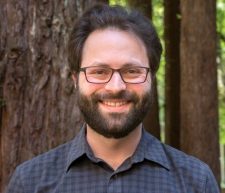
My research group was working on understanding and controlling electronic energy transfer between conjugated polyelectrolytes (CPEs) for light-harvesting applications. In the course of this work, an idea occurred to us that at high ionic strength it might be possible to form a water-based complex fluid phase – called a polyelectrolyte complex coacervate – using a CPE. This would give rise to a semiconducting polymer-rich fluid that would be aqueous yet highly oleophilic. Elucidating the influence of chemical structure on the strong coupling between ionic and electronic degrees of freedom in such a unique fluid would be of fundamental interest to polymer science. Because this idea was outside the normal domain of our work, we submitted a successful PRF New Directions proposal. Without this award, we would not have been able to undertake this research. The funds that we received went towards training and supporting graduate students, both of whom are underrepresented in the sciences, in a physical chemistry PhD program at UC Santa Cruz. Along the way, one of the students demonstrated evidence of an aqueous CPE-based complex coacervate (manuscript under review), and another student used this work as a springboard to show that CPEs can form ionically assembled, tunable semiconducting hydrogels even at salt concentrations as high as that of the ocean (manuscript in preparation). We are extremely grateful to the ACS PRF for making this work possible.
Dr. Alexander Ayzner, University of California, Santa Cruz
PRF grants have had an enormous impact on American chemistry. When I began my independent career, there was virtually no “start-up money” for new faculty. Many young faculty began with a PRF “Type G” grant. The amount of money was negligible (I’m old enough that I no longer remember how negligible), but it gave young faculty their first experience at managing a grant, and impressed their department (someone cared about what you planned to do). Of course the experience in proposal writing was invaluable. I never did the platinum chemistry in my original Type G proposal, but someone else had the same ideas independently — and, much later, did the research. It actually worked! The more recent New Directions grants allow faculty to get preliminary results before they apply for major funding. Such funding is more and more difficult to get, and the time it takes to get such proposals evaluated gets longer and longer – so PRF grants are increasingly indispensable.
Dr. Jack R. Norton, Columbia University, New York, NY
I had accepted an offer to start as an assistant professor at Hunter College of City University of New York for September 1967, while I was an NSF Postdoctoral Fellow in Zurich. So I wrote an application for a PRF Type G grant, proposing a research project on spectroscopy of liquid crystals. I asked my postdoctoral advisor, Prof. Hans Gunthard, to write a supporting letter for the grant. He asked me what to say, being unfamiliar with this process. So I said "Look, hundreds of new faculty apply for these, something has to make this stand out. So you need to say something like ‘this research, if successful, will likely lead to Dr Bulkin winning the Nobel Prize in Chemistry’." I believe that is what he wrote. I received the grant, and as it turned out I was the first new faculty member at City University (the doctoral program was very new then) to get a Type G grant. I believe it was $5000. Richard Wiley, the Chairman of the Chemistry Doctoral program said to me we are going to get you some more money. So he marched me down to see the Graduate Dean at Hunter College, and said ‘This young man just got a prestigious grant for $5000. You should help him by matching it’. Which she did. Then he took me to see the President of the Graduate Center and said pretty much the same thing, leading to another $5000. So the PRF Type G grant wound up giving me $15000 to spend on my research, which may not seem like much now but was a big help in getting me started.
Dr. Bernard J. Bulkin, Hunter College, City University of New York
I’m an old emeritus who began a faculty position in physical chemistry at Lehigh University in fall, 1956. My background was in nuclear and radiation chemistry (Notre Dame and Wisconsin), a very recognized topic following the Atomic Bomb of WW II. To expand the scope, I proposed to PRF a study of “vacuum ultraviolet photochemistry.” The PRF grant supported my first PhD student, Allan H. Laufer, who then joined the group of Dr. James McNesby at what became NIST. Dr. Laufer had his entire productive career in that group which used isotopic labeling to highlight a process called “molecular detachment.” I am very grateful for the PRF Committee’s support.
Dr. James E. Sturm, Lehigh University, Bethlehem, PA
In 1983, Dave Tirrell had just joined UMass Polymer Science & Engineering as a young professor. This was a return for Dave, having graduated the still-young PSE dept under Otto Vogl a few years earlier. Dave was actually moving into Otto’s old lab since he had just departed for Brooklyn Polytechnic, and it was my first job as a grad student to clean it, including the disposal of a variety of chemical waste left behind – such as 20 gal of chloral hydrate (or enough Mickey Finn to knock out all of Amherst!) This provided an early lesson in paperwork and red-tape, certainly useful later to me in industry. And worth the effort because I got to pick the best hood in the new lab for my initial project to study radical addition reactions to alkenes. When Dave told me that my entire first year funding was supported by PRF, I recall being very grateful, and such was my launch into a polymers career that included oil and gas research.
Dr. Douglas Cywar, Cychem LLC, Danbury, CT

